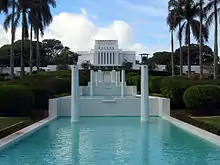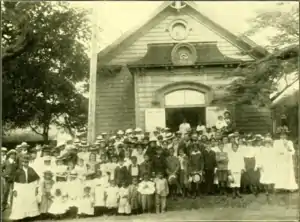The Church of Jesus Christ of Latter-day Saints in Hawaii
The Church of Jesus Christ of Latter-day Saints (LDS Church) was established in the Hawaiian Islands in 1850, 11 years after the Edict of Toleration was decreed by Kamehameha III, giving the underground Hawaii Catholic Church the right to worship, and at the same time allowing other faith traditions to begin establishing themselves.

The first LDS Church missionary to have success among the Hawaiians was George Q. Cannon. Among his earliest converts were men well-versed in the Hawaiian language, such as Jonatana Napela and Uaua. After the construction of the Hawaii Temple, the Latter-day Saints founded the Church College of Hawaii, now Brigham Young University-Hawaii (BYU-Hawaii), along with the associated Polynesian Cultural Center (PCC), the state's largest living museum, and an entertainment center;[1] which draws a million visitors annually. As the Latter-day Saint population in Hawaii continued to increase, a second church temple for the islands, the Kona Hawaii Temple, was completed in Kailua Kona on the island of Hawaii in 2000.
As of September 1, 2018, there were 74,278 Latter-day Saints organized into 16 stakes, 125 wards, and 16 branches, in Hawaii, and there was one mission. In addition, there were 26 Family History Centers, used for genealogical research and study.[2] Hawaii has the highest concentration of Latter-day Saints of U.S. states that do not border Utah.
History

The first ten LDS Church missionaries departed San Francisco for Hawaii during the California Gold Rush on the ship Imaum of Muscat, arriving on December 12, 1850, in Honolulu Harbor of what was then known as the Sandwich Islands.[3] With Hiram Clark presiding, the missionaries included Henry Bigler, Hiram Blackwell, George Q. Cannon, John Dixon, William Farrer, James Hawkins, James Keeler, Thomas Morris, and Thomas Whittle. A day after their arrival the group climbed a hill above Honolulu (Pacific Heights), constructed a small, makeshift altar and said a prayer. A week later, the ten missionaries received their assignments: Farrer and Dixon headed to the island of Kaua'i, Cannon, Keeler, and Bigler to Lahaina on the island of Maui, Blackwell and Hawkins to the Big Island of Hawaii, with Morris, Whittle, and Clark staying behind in Honolulu. This group formed the basis of the Sandwich Islands Mission.[4] The church's first congregation in Hawaii was established on the island of Maui in 1851.[5] Among the early converts of Cannon were three prominent native Hawaiians: Napela, Uaua and Kaleohano who would later serve as prominent missionaries and leaders in the LDS Church.[6]
Missionaries lead a group of Hawaiian Latter-day Saints in establishing a colony on the island of Lānaʻi in 1854.[7] In 1857, the American missionaries left due to the Utah War. No new missionaries came until Walter M. Gibson arrived in 1861. Gibson instituted irregular activities such as selling the priesthood. Some local leaders, such as Napela, sent letters to Salt Lake City asking for Gibson to be replaced. In response, Ezra T. Benson and Lorenzo Snow of the church's Quorum of the Twelve Apostles were sent to take over the leadership of the mission, with the assistance of Joseph F. Smith, who had been a missionary in Hawaii for much of the 1850s. Most of the membership followed Benson, Snow, and Smith, but in the process ownership of the property on Lanai was lost. A new colony for Hawaiian Latter-day Saints was established in Lāʻie.[8]
In 1889, Iosepa, Utah was founded as a colony for Hawaiian Latter-day Saints. This colony functioned until 1915 when the saints there were encouraged to return to Hawaii in anticipation of the building of a temple there. The first stake in Hawaii was organized in 1935.[9]
In 1937, the Japanese Mission was organized in Hawaii to focus on teaching the ethnic Japanese in Hawaii. This mission existed until 1950 when it was merged into the Hawaiian mission.[10]
In 2020, the LDS Church canceled services and other public gatherings indefinitely in response to the coronavirus pandemic.[11]
Temples
The Laie Hawaii Temple, formerly known as the Hawaiian Temple or the Hawaii Temple until a standard naming convention for LDS temples was adopted in the early 2000s, is located on the northeast shore of the island of Oʻahu. The temple sits on a small hill a half-mile from the Pacific Ocean in the town of Laie, 35 miles (56 km) from Honolulu. Along with BYU-Hawaii and the PCC, the temple plays an important role in the town of Lā'ie,[12] with the temple Visitors' Center attracting more than 100,000 people annually.[13]
The Hawaii Temple was the first temple the LDS Church built outside of the continental United States. The temple is also the oldest to operate outside of Utah, and the fifth-oldest still in operation. The site of the temple was dedicated by church president Joseph F. Smith on June 1, 1915, and the completed structure was dedicated by church president Heber J. Grant on November 27, 1919.
The Kona Hawaii Temple became the church's seventieth temple, announced on May 7, 1998. Located in the town of Kailua-Kona on the island of Hawai‘i, the site of Kona Hawaii Temple was dedicated on March 13, 1999. The structure itself was constructed in concrete, white marble and some native materials. Architects used a simple classical design featuring a single spire. The completion and official dedication was celebrated on January 23, 2000 by church president Gordon B. Hinckley.
|
|
5. Laie Hawaii Temple | ||
|
Location: |
Laie, Hawaii, United States | ||
|
|
70. Kona Hawaii Temple | ||
|
Location: |
Kailua-Kona, Hawaii, United States | ||
Notes
- Polynesian Cultural Center Official Site. Polynesia.com. Retrieved on 2010-12-22.
- "The Church of Jesus Christ of Latter-day Saints". The Newsroom The Official Resource for the News Media, Opinion Leaders and the Public. Intellectual Reserve, Inc. Retrieved 12 February 2019.
- Bureau of Information 1964, pp. 3.
- Wallace III 2000
- Bureau of Information 1964, pp. 7.
- LDS Church Almanac 2010 Edition, p. 331
- Bureau of Information 1964, pp. 8.
- LDS Church Almanac 2010 edition, p. 331
- LDS Church Alamanc, 2010 edition, p. 331
- LDS Church Almanac, 2010 edition, p. 331
- Lovett, Ian. "Mormon Church Cancels Services World-Wide Amid Coronavirus Crisis", The Wall Street Journal, 12 March 2020. Retrieved on 31 March 2020.
- Aikau, Hokulani K. (Winter 2008). "Resisting Exile in the Homeland: He Mo'olemo No Lā'ie". American Indian Quarterly. Lincoln, Nebraska: University of Nebraska Press. 32 (1): 70–95. doi:10.1353/aiq.2008.0003. ISSN 0095-182X.
- Kayal, Michele (2004-11-27). "Mormons Spruce Up Their Aging Hawaiian Outpost". The New York Times. Retrieved 2007-11-18.
- A prior rededication by Spencer W. Kimball took place on June 13, 1978. See: "Dedications at Seattle, Temple Square, Hawaii, and Nauvoo", Ensign (News of the Church), July 1978
- "Laie Hawaii Temple Rededicated by President Monson", Newsroom (News Release), LDS Church, November 21, 2010
- "Plans announced for renovation of Laie Hawaii Temple", Deseret News, October 7, 2008
References
- Wallace III, William Kauaiwiulaokalani (2000-01-30). "The Church of Jesus Christ of latter-day Saints In the Hawaiian Islands from 1850–1900;". La'ie Community Association. Retrieved 2007-11-17. Cite journal requires
|journal=(help). - Bureau of Information, Hawaii Temple (1964). "The Mormon temple, Laie, Hawaii". LDS Church: 1–20. Cite journal requires
|journal=(help). - Grant Underwood, ed. (2000). Voyages of Faith: Explorations in Mormon Pacific History. Provo, Utah: Brigham Young University Press. ISBN 0-8425-2480-0..
Further reading
- Jackson, Richard W. (2003). "Places of Worship: 150 Years of Latter-day Saint Architecture" (PDF). Provo, Utah. Religious Studies Center, Brigham Young University. Retrieved 2008-08-08.
External links
- Newsroom (Hawaii)
- ComeUntoChrist.org Latter-day Saints Visitor site
- The Church of Jesus Christ of Latter-day Saints Official site
- Deseret News 2010 Church Almanac - Hawaii


